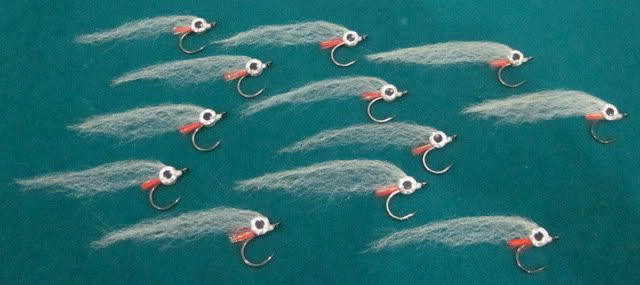Just for fun

I've been doing an SBS for the Openshaws Ghost fly I mentioned elsewhere. Its a simple tie and very effective.
Some good techniques too, that can be adapted for either UK salt, Pike or perhaps other baitfish patterns

Hook: Gamakatsu 3/0 (don't know the number it was written in chinese

)
Thread: White flat mono thread
Throat: Red DnA Holofusion
Wing: White Slinky fiber
Overwing: Tan EP Fibres
Eyes: 1/2" 3D eyes
Step 1. Put hook in vice at a slight angle.

Step 2. Wind on thread just cover the first 1/3 of the shank

Step 3. Take a smallish bunch of Holofusion and tie in at the mid point.

Step 4. Fold the fibres back and tie down (approx 1/3 rd of the area covered by the thread), trim to length of the hook.

Step 5. Take some slinky fibers, the whole length of the hank. Look at the amount you think is correct and then use 1/3rd (about 20-25 fibres) Tie in with approx 2/5ths extending backwards and butting up to the hump created by the holofusion tie in. tie it down over 1/2 of the remaining gap to eye.

Step 6. Fold the fibers back and tie down.

Step 7. Take a length of EP Fibres (full length of hank) aprrox 1/3 rd of the amount of Slinky (7-10 fibres) and tie down in the remaining space to eye.

Step 8. Fold back and tie down up to where the hump formed by the slinky is

Step 9. Whip finish and trim wing to shape.

Step 10. Remove fly from vice and put on a flat surface brush wing out to desired shape with fingers , get two eyes ready and turn upside down. Mix up some epoxy.

Step 11. Apply a good blob of epoxy to the back of each eye, position one eye on one side as shown (Apologies for the crap picture i had one shot at it due to 5 min epoxy curing fast)

Step 12. Mount the other eye on the opposite side.

Step 13. Press eyes together until a small amount of epoxy squeezes out of the sides, apply some epoxy to the exposed thread for a head and mount in a fly drier (don't switch it on) you may have to squeeze them together a couple of times. Make sure you straighten the fly on the hook before it sets


Step 14. Once dry (very soon) the wing will retain its shape and density to look very transparent. It will be light and easy to cast.

Here are the ones i have tied up for a flyswap. Its an Australian pattern although i have modified it slightly to make it more me


here are the same flies going for a we swim as a shoal

If you half close your eyes its really effective


Cheers
Sandy

